Drawer vs. no drawer? Ruptured cruciate or not? Meniscus intact or not? Scope the knee or not? Who needs a scope when you have aprobe, some, gel, and a SonoPath radiologist who knows orthopedic ultrasound like Dr. Nele Ondreka DipECVDI of the University of Giessen, Germany? It's a limp, a knee, a probe, and a scalpel that defines diagnostic and therapeutic efficiency in the month's case of the month.
Image Interpretation
Ultrasonographic examination of the left & right stifle: Left stifle joint: Both the supra- and infrapatellar recess of the left stifle joint contain a moderate amount of anechoic effusion. The joint capsule reveals marked thickening and synovial proliferation. The cartilage layers as appreciated onto the femoral trochlea and the femoral condyles present mildly uneven in surface and with multifocal increase of echogenicity as far as seen. A moderate amount of osteophytes is noted at the periarticular margins of the femoropatellar and femorotibial joints. The cranial cruciate ligament (CCL) presents as a broad band of echogenic tissue at the intercondylar eminence of the tibia with periligamentous effusion as well as prominent regional synovial thickening. The infrapatellar fat body presents heterogenous increase in echogenicity and cyst formation as found commonly in chronic degenerative joint disease (DJD). The view on the medial meniscus is limited. Only the cranial horn is seen. As far as visible it is in situ but reveals irregular surface and outline. The lateral meniscus is not directly seen. Right stifle joint: Both the supra- and infrapatellar recess of the right stifle joint reveal marked anechoic effusion. The joint capsule reveals moderate thickening. Moderate synovial proliferations are noted. The cartilage layers as appreciated onto the femoral trochlea and the femoral condyles are uneven with multifocal indentations and increased echogenicity as far as seen. A mild amount of osteophytes is noted at the periarticular margins mainly at the femoropatellar joint. The cranial cruciate ligament (CCL) presents as a discontinuous echogenic band at the intercondylar eminence of the tibia. There is periligamentous effusion as well as regional synovial thickening. The medial and lateral meniscus are within normal limits.
DX
The findings of the left stifle joint are compatible with moderate to severe generalized chronic degenerative joint disease (DJD) with joint effusion, osteophytosis, capsular fibrosis and synovial proliferation. There is evidence of full rupture of the cranial cruciate ligament with biomechanical failure. The visibility of the medial meniscus is limited which may be due to the anatomic conformation of the stifle joint. Yet meniscal damage is likely with the findings here. The findings of the right stifle joint are compatible with moderate generalized chronic degenerative joint disease (DJD) with moderate effusion, mild osteophytosis and moderate synovial proliferation. Moreover the findings are suggestive for biomechanical instability due to cranial cruciate ligament failure. There is no ultrasonographic evidence of meniscal injury.
Outcome
Surgical therapy addressing the biomechanical failure and prevent progression of the DJD & further damage is indicated for both stifle joints one at a time. The succession of the therapeutic management should be tailored to the clinical signs. This patient was referred to Crown Veterinary Specialists for surgical repair of the left stifle, her primary complaint. A medial approach was made to the left stifle. There was moderate osteophyte formation present on the medial and lateral trochlear ridges that were removed with rongeurs. The torn ACL remnants were removed, the normal medial meniscus was left intact. The tibial tuberosity was osteotomized, advanced and stabilized with a 9 cage, and 6 fork end plate. The osteotomy site was packed with cancellous bone graft harvested from the medial aspect of the distal femur. The fascia and joint capsule was apposed with 0 pds, sc, 2.0 pds, skin was apposed with 2-0 nylon. Recommend bandage removal in 2 days, suture removal in 2 weeks and radiographs of the left limb taken at 8 and 16 weeks, sooner if there are problems.

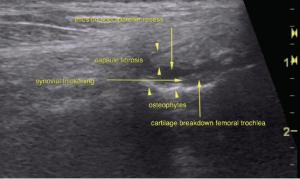
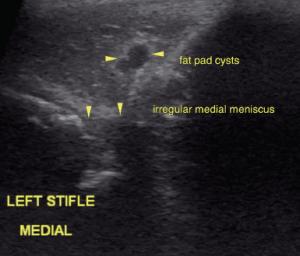

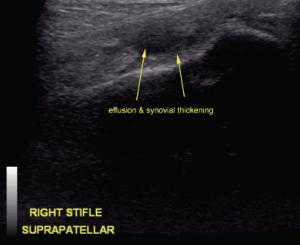
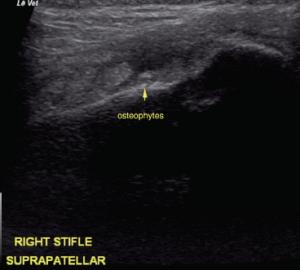
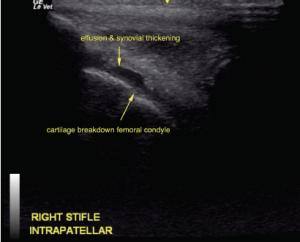

Comments
Case management by Jennifer Louks, DVM and Cheri Smith, DVM of Whippany Veterinary hospital. Surgery was performed at Crown Veterinary specialists by Anji Cooley, DVM.